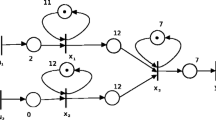Abstract
This work deals with the control problem of Discrete Event Systems (DESs) modelled by Timed Event Graphs (TEGs) and subject to Generalized Marking Constraints (GMCs). The aim of this paper is to propose an algebraic methodology for the determination of control laws in the form of state feedback, guaranteeing the satisfaction of marking specifications expressed by weighted inequalities in the Min-Plus algebra. The resultant controller can be represented by marked and timed control places, connected to the initial TEG model. The role of the established feedback is to limit the number of tokens in weighted paths for partially observable TEGs. In order to illustrate and show the interest of these current studies, we applied the suggested control method to a machine of filling bottles with liquid.





Similar content being viewed by others
Data availability
All data used to support the findings of this study are included within the manuscript.
References
Atli M, Adjallah K, Achour Z, Sava A, Rezg N (2011) Supervisory control of timed-place marked graph based on Marking Exclusion Constraint. IEEE International Conference on Communications, Computing and Control Applications(CCCA’11), Tunis, Tunisia 1–8
Atto AM, Martinez C, Amari S (2011) Control of discrete event systems with respect to strict duration: Supervision of an industrial manufacturing plant. Computers and Industrial Engineering Elsevier 61(4):1149–1159
Baccelli F, Cohen G, Olsder G, Quadrat J (1992) Synchronization and Linearity: An algebra for Discrete Event Systems. Wiley 2: New York
Basile F, Cordone R, Piroddi L (2021) Supervisory control of timed discrete event systems with logical and timed specifications. IEEE Trans Autom Control 67(6):2800–2815
Candido RMF, Hardouin L, Lhommeau M, Santos-Mendes R (2018) Conditional reachability of uncertain Max-Plus linear systems. Au- Tomatica 94(9):426–435
Cassandras CG, Lafortune S (2009) Introduction to Discrete Event Systems (2nd Edition). Springer Science & Business Media, New York: USA
Cottenceau B, Hardouin L, Boimond JL (2013) Modeling and control for balanced timed and weighted event graphs in dioid. IEEE Trans Autom Control 59(5):1219–1231
Espindola-Winck G, Hardouin L, Lhommeau M, Santos-Mendes R (2022) Stochastic filtering scheme of implicit forms of uncertain Max-Plus linear systems. IEEE Trans Autom Control 67(8):4370–4376
Giua A, DiCesare F, Silva M (1992) Generalized mutual exclusion constraints on Petri nets with uncontrollable transitions. In Proceedi- Ngs IEEE International Conference on Systems Man and Cybernetics 2:974–979
Houssin L, Lahaye S, Boimond JL (2013) Control of (max,+)-linear systems minimizing delays. Discrete Event Dynamic Systems, Springer Verlag 23(3):261–276
Iordache MV, Antsaklis PJ (2006) Supervision Based on Place Invariants: A Survey. Discrete Event Dynamic Systems 16:451–492
Jacob R, Amari S (2017) Output Feedback Control of Discrete Processes under Time Constraint: Application to Cluster Tools. Internati- Onal Journal of Computer Integrated Manufacturing 30(8):880–894
Katz R (2007) Max-Plus (A, B)-invariant spaces and control of timed discrete-event systems. IEEE Trans Autom Control 52(2):229–241
Kim C, Lee TE (2016) Feedback control of cluster tools for regulating wafer delays. IEEE Trans Autom Sci Eng 13(2):1189–1199
Li L, Basile F, Li Z (2019) An approach to improve permissiveness of supervisors for GMECs in time Petri net systems. IEEE Trans Autom Control 65(1):237–251
Li L, Basile F, Li Z (2020) Closed-Loop Deadlock-Free Supervision for GMECs in Time Petri Net Systems. IEEE Trans Autom Control 66(11):5326–5341
Li L, Basile F, Wang J (2021) An approach for enforcing a class of GMECs on time Petri net with uncontrollable transitions. Inf Sci 580:897–916
Ma ZY, Li ZW, Giua A (2016) Petri Net Controllers for Generalized Mutual Exclusion Constraints with Floor Operators. Automatica 74:238–246
Maia CA, Andrade CR, Hardouin L (2011) On the control of Max-Plus linear system subject to state restriction. Automatica 47(5):988–992
Maia CA, Andrade CR, Hardouin L, Cury JER (2013) Some results on the feedback control of Max-Plus linear systems under state constraints. In: Decision and Control (CDC) IEEE 52nd Annual Conference: 6992–6997
Mendes RS, Hardouin L, Lhommeau M (2019) Stochastic filtering of Max-Plus linear systems with bounded disturbances. IEEE Trans Autom Control 64(9):3706–3715
Murata T (1989) Petri nets Properties analysis and applications. Proc IEEE 77(4):541–580
Ramchandani C (1973) Analysis of asynchronous concurrent systems by timed Petru nets. PhD thesis, Massachusetts Institute of Technology, Cambridge, MA. https://hdl.handle.net/1721.1/149425
Sifakis J (1980) Performance evaluation of systems using nets. Net Theory and Applications 84:307–319
Sifakis J (1977) Use of Petri nets for performance evaluation. Conference Measuring, Modelling and Evaluating Computer Systems, Proceedings of the third International Symposium, Bonn-Bad Godesberg, Germany 3–5
Silva M (2018) On the history of Discrete Event Systems. Annu Rev Control 45:213–222
Špaček P, Komenda J, Lahaye S (2021) Analysis of P-time event graphs in (max,+) and (min,+) semirings. Int J Syst Sci 52(4):694–709
Tebani K, Amari S (2021) Min-Plus realizable control design for partially observable timed event graphs under marking constraints. Eur J Control 57:33–40
Tebani K, Amari S, Kara R (2019) State Feedback Control for a class of Timed Petri Nets subject to marking constraints. Asian Journal of Control 21(3):1–18
Yamalidou K, Moody J, Lemmon M, Antsaklis P (1996) Feedback control Petri net based on place Invariant. Automatica 32(1):15–28
Author information
Authors and Affiliations
Corresponding author
Ethics declarations
Conflict of interest
The authors declare that they have no conflict of interest.
Additional information
Publisher's Note
Springer Nature remains neutral with regard to jurisdictional claims in published maps and institutional affiliations.
Rights and permissions
Springer Nature or its licensor (e.g. a society or other partner) holds exclusive rights to this article under a publishing agreement with the author(s) or other rightsholder(s); author self-archiving of the accepted manuscript version of this article is solely governed by the terms of such publishing agreement and applicable law.
About this article
Cite this article
Rajah, J., Amari, S., Barkallah, M. et al. An algebraic control method to guarantee generalized marking constraints for partially observable timed event graphs. Discrete Event Dyn Syst (2024). https://doi.org/10.1007/s10626-024-00398-y
Received:
Accepted:
Published:
DOI: https://doi.org/10.1007/s10626-024-00398-y




